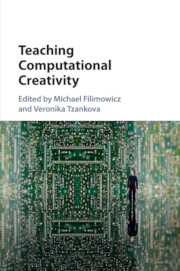Refine search
Actions for selected content:
2540 results in Computational Science
6 - Multi-Dimensional Graphics
-
- Book:
- Python for Scientists
- Published online:
- 02 August 2017
- Print publication:
- 20 July 2017, pp 109-128
-
- Chapter
- Export citation
Contents
-
- Book:
- Python for Scientists
- Published online:
- 02 August 2017
- Print publication:
- 20 July 2017, pp v-x
-
- Chapter
- Export citation
Appendix B - Fortran77 Subroutines for Pseudospectral Methods
-
- Book:
- Python for Scientists
- Published online:
- 02 August 2017
- Print publication:
- 20 July 2017, pp 244-249
-
- Chapter
- Export citation

Teaching Computational Creativity
-
- Published online:
- 04 July 2017
- Print publication:
- 02 May 2017
5 - Whitham Modulation Theory – the Lagrangian Viewpoint
-
- Book:
- Symmetry, Phase Modulation and Nonlinear Waves
- Published online:
- 30 June 2017
- Print publication:
- 03 July 2017, pp 43-52
-
- Chapter
- Export citation
17 - Non-conservative PDEs and Modulation
-
- Book:
- Symmetry, Phase Modulation and Nonlinear Waves
- Published online:
- 30 June 2017
- Print publication:
- 03 July 2017, pp 185-190
-
- Chapter
- Export citation
11 - Generic Whitham Modulation Theory in 2+1
-
- Book:
- Symmetry, Phase Modulation and Nonlinear Waves
- Published online:
- 30 June 2017
- Print publication:
- 03 July 2017, pp 107-119
-
- Chapter
- Export citation
2 - Hamiltonian ODEs and Relative Equilibria
-
- Book:
- Symmetry, Phase Modulation and Nonlinear Waves
- Published online:
- 30 June 2017
- Print publication:
- 03 July 2017, pp 11-19
-
- Chapter
- Export citation
Index
-
- Book:
- Symmetry, Phase Modulation and Nonlinear Waves
- Published online:
- 30 June 2017
- Print publication:
- 03 July 2017, pp 226-228
-
- Chapter
- Export citation
1 - Introduction
-
- Book:
- Symmetry, Phase Modulation and Nonlinear Waves
- Published online:
- 30 June 2017
- Print publication:
- 03 July 2017, pp 1-10
-
- Chapter
- Export citation
Appendix B - Derivatives of a Family of Relative Equilibria
-
- Book:
- Symmetry, Phase Modulation and Nonlinear Waves
- Published online:
- 30 June 2017
- Print publication:
- 03 July 2017, pp 198-200
-
- Chapter
- Export citation
6 - From Lagrangians to Multisymplectic PDEs
-
- Book:
- Symmetry, Phase Modulation and Nonlinear Waves
- Published online:
- 30 June 2017
- Print publication:
- 03 July 2017, pp 53-66
-
- Chapter
- Export citation
Appendix C - Bk and the Spectral Problem
-
- Book:
- Symmetry, Phase Modulation and Nonlinear Waves
- Published online:
- 30 June 2017
- Print publication:
- 03 July 2017, pp 201-204
-
- Chapter
- Export citation
References
-
- Book:
- Symmetry, Phase Modulation and Nonlinear Waves
- Published online:
- 30 June 2017
- Print publication:
- 03 July 2017, pp 216-225
-
- Chapter
- Export citation
Appendix E - Advanced Topics in Multisymplecticity
-
- Book:
- Symmetry, Phase Modulation and Nonlinear Waves
- Published online:
- 30 June 2017
- Print publication:
- 03 July 2017, pp 208-215
-
- Chapter
- Export citation
3 - Modulation of Relative Equilibria
-
- Book:
- Symmetry, Phase Modulation and Nonlinear Waves
- Published online:
- 30 June 2017
- Print publication:
- 03 July 2017, pp 20-25
-
- Chapter
- Export citation
4 - Revised Modulation Near a Singularity
-
- Book:
- Symmetry, Phase Modulation and Nonlinear Waves
- Published online:
- 30 June 2017
- Print publication:
- 03 July 2017, pp 26-42
-
- Chapter
- Export citation
Appendix D - Reducing Dispersive Conservation Laws to KdV
-
- Book:
- Symmetry, Phase Modulation and Nonlinear Waves
- Published online:
- 30 June 2017
- Print publication:
- 03 July 2017, pp 205-207
-
- Chapter
- Export citation
8 - Phase Modulation and the KdV Equation
-
- Book:
- Symmetry, Phase Modulation and Nonlinear Waves
- Published online:
- 30 June 2017
- Print publication:
- 03 July 2017, pp 74-86
-
- Chapter
- Export citation
14 - Modulation of Three-Dimensional Water Waves
-
- Book:
- Symmetry, Phase Modulation and Nonlinear Waves
- Published online:
- 30 June 2017
- Print publication:
- 03 July 2017, pp 149-168
-
- Chapter
- Export citation
